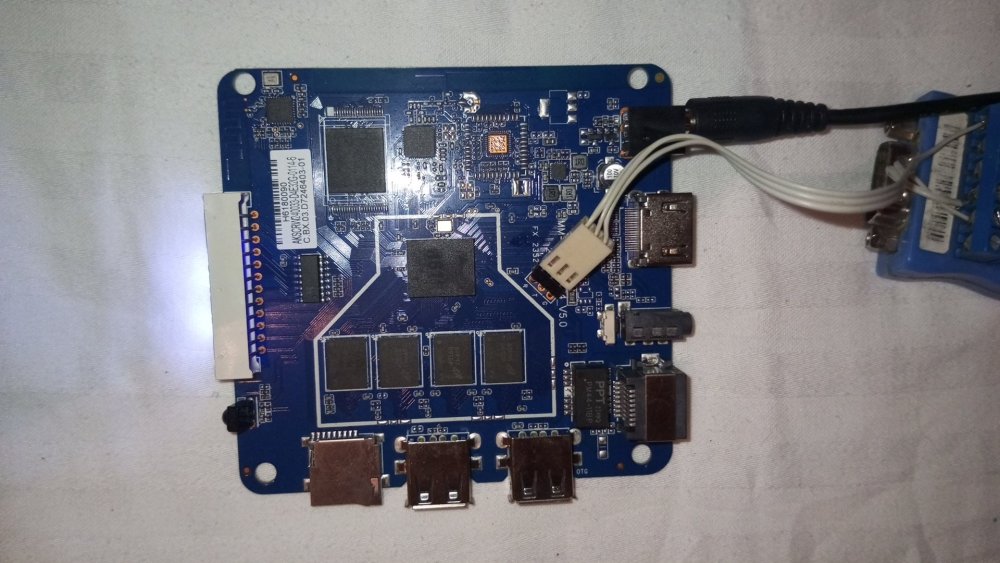All Activity
- Past hour
-

Need Kernel source for linux-image-current-sunxi64 6.12.20
going replied to ovacikar's topic in Orange Pi Zero 2
The kernel headers that you have installed are quite enough to build the kernel module, the source codes of which you have. If the source codes are already in the kernel, then you just need to configure the kernel before compiling. launch: After you finish the configuration, the build system saves your configuration file (it will tell you where it did it). Save it under the name ./config/kernel/linux-sunxi64-current.config It is assumed that you are in the armbian/build directory. launch: ./compile.sh BOARD=orangepizero2 BRANCH=current kernel -
@svyatoslav there’s a driver for the wifi chip but it only works on older kernels. You’ll need to port the code over to the latest kernel. https://github.com/paolosabatino/ssv6x5x/tree/master Click on the show csc/wib/eos/tvb button. You will see x98h and other h618/h616 boxes there.
-
@kvvvp try this sudo update-alternatives --set iptables /usr/sbin/iptables-legacy sudo update-alternatives --set ip6tables /usr/sbin/ip6tables-legacy
-
wrong. auto-login is enabled on serial and hdmi only. ssh default login is always root/1234
-
Thanks for the reply, Pilinha. How did you manage to SSH into the system without a keyboard? I planned to do that, but then i realized that I needed to set up a root password beforehand and I could not do that without a keyboard.
-
Thanks, Igor. I totally understand that when this project started you guys had to take care of a handful of boards and now there must be hundreds of them and that it is not feasible to support every one of them, especially the older ones. It is indeed clearly marked as community support on the board page. I, nonetheless, accepted the challenge (I might fail, I might succeed). Thank you for your work, in general, and for the links, in particular (which I will read).
- Today
-
I am getting a thermal zone failure message during boot, which has always happened with kernels after 6.6, at least as far as I know. Is this error actually harmful? HardWare:NanoPi NEO2 Armbian Version: Packages: Debian stable (bookworm) v25.2.3 for NanoPi Neo 2 running Armbian Linux 6.12.20-current-sunxi64 Support: DIY (community maintained) Kernel: Linux nanopineo2 6.12.20-current-sunxi64 #1 SMP Sat Mar 22 19:54:28 UTC 2025 aarch64 GNU/Linux dmesg output [ 7.018086] core: _opp_supported_by_regulators: OPP minuV: 1320000 maxuV: 1320000, not supported by regulator [ 7.018125] cpu cpu0: _opp_add: OPP not supported by regulators (1104000000) [ 7.018245] core: _opp_supported_by_regulators: OPP minuV: 1320000 maxuV: 1320000, not supported by regulator [ 7.018258] cpu cpu0: _opp_add: OPP not supported by regulators (1200000000) [ 7.018413] core: _opp_supported_by_regulators: OPP minuV: 1340000 maxuV: 1340000, not supported by regulator [ 7.018426] cpu cpu0: _opp_add: OPP not supported by regulators (1296000000) [ 7.018552] core: _opp_supported_by_regulators: OPP minuV: 1400000 maxuV: 1400000, not supported by regulator [ 7.018564] cpu cpu0: _opp_add: OPP not supported by regulators (1368000000) [ 7.019699] thermal thermal_zone0: binding cdev cpufreq-cpu0 to trip 3 failed: -22 [ 7.019785] thermal thermal_zone0: binding cdev cpufreq-cpu0 to trip 4 failed: -22 dmesg.txt
-
Early May brought another round of steady advancements to the Armbian project, with progress in U-Boot updates, board enablement, firmware fixes, and notable improvements to Armbian’s growing catalog of self-hosted applications. Bootloader and Firmware Enhancements Several platforms saw significant U-Boot improvements. The Cherryba-M1 now benefits from an upgraded U-Boot and reorganized patch structure, thanks to Igor‘s work on upgrading Cherryba-M1 to latest u-boot and moving patch to new folder. Andy bumped U-Boot to v2025.04 for the Lubancat2, keeping the board current. The Radxa Rock 4 SE also migrated to this version, where Niklas refined its configuration and boot behavior. Meanwhile, the Khadas VIM3 received a broader bootloader overhaul led by Ricardo, introducing SD-first boot order, squashfs and fileenv support, and enhanced compatibility with Home Assistant OS in a comprehensive update to U-Boot for Khadas VIM3. Older configurations didn’t go unnoticed: Igor removed deprecated ATF tags for sun50iw9 / H61x, while Olaf pushed the sunxi64 platform to the latest LTS version of ATF. Expanding Device Support Armbian continues to grow its ecosystem. Rolf introduced official support for the Banana Pi M2+, making it easier for users to deploy on this compact board. On the RISC-V side, libiunc brought the kernel for the StarFive2 platform up to v6.6, ensuring ongoing support and compatibility. Installer Improvements and Runtime Fixes Improving install experience, Igor Velkov added Btrfs root subvolume support when installing to NVMe, paving the way for better snapshot and maintenance workflows. Igor also corrected missing Broadcom firmware for Raspberry Pi boards to fix wireless support and suppressed firmware warnings related to built-in Realtek USB network drivers, helping clean up logs and reduce confusion. Self-Hosted App Catalog Grows The list of installable apps during Armbian setup has expanded. Two powerful platforms are now just a selection away: Immich, a self-hosted photo and video backup system, was added with the introduction of Immich to configNG. NetBox, a leading infrastructure resource management solution, joined the roster in the addition of NetBox to Armbian configNG. Both are available via the configNG provisioning interface. Deprecations and Housekeeping Support for legacy distributions has now ended: Debian Bullseye and Ubuntu Focal and Jammy will no longer receive repository updates, as noted in the userspace status change to EOS. Elsewhere, dependency and CI maintenance continued. Automated tools like Dependabot bumped packages such as setuptools and GitHub actions for changed-files, while amazingfate restored support for the AIC8800 Wi-Fi driver by reverting a mistaken disable. Further Reading Explore the full range of updates in the official Armbian snapshot. The post Armbian Development Highlights – Early May 2025 first appeared on Armbian. View the full article
-

Need Kernel source for linux-image-current-sunxi64 6.12.20
ovacikar replied to ovacikar's topic in Orange Pi Zero 2
I set the version in userpatches/lib.config , then executed this: ./compile.sh BOARD=orangepizero2 BRANCH=current kernel-config KERNEL_BTF=no KERNEL_GIT=full and when the kernel menu came up, just exited to shell. Is this the kernel source directory I can point the compiler script of the module ? /build/cache/sources/linux-kernel-worktree/6.12__sunxi64__arm64$ ls arch COPYING defconfig fs io_uring Kconfig LICENSES mm rust security usr block CREDITS Documentation include ipc kernel MAINTAINERS net samples sound virt certs crypto drivers init Kbuild lib Makefile README scripts tools -
this is what dmesg looks like I decided to assemble it myself, but it was not there, which one to choose? same thing, what to do next? dmesg.txt
-
Hi, Providing logs with armbianmonitor -u helps with troubleshooting and significantly raises chances that issue gets addressed.
-
.thumb.jpg.20ed26dd68aaee94a94b227bf670a8eb.jpg)
Problems after kernel 6.12.17-current-rockchip64 update
SuperKali replied to fever_wits's topic in Rockchip
if you want zfs on recent kernel you've to compile it manually, this worked on kernel 6.14.5 on Radxa Rock 5 ITX. -
No, unfortunately not. But there was an image, among many others that I tested that worked, but it had other problems, I don't remember anymore. And even if I want to recover it, I can't find it anymore. I spent a lot of time testing a lot of images, and then I just started putting in a folder the ones that ran well at boot and started without problems. I have a four or five, but all without working usb ports. However, since I only wanted to install the Pi-Hole on it, I found that I could access it via a computer via SSH. And since then everything has been much easier, even higher with the help of our friend CHATGPT!! And even then, the image that finally worked is where I installed the Pi-Hole. must have problems. From time to time it freezes. I see that I'll have to test others. If there is news, I will say so. And if you also have any news, please share it. Hug
-

Need Kernel source for linux-image-current-sunxi64 6.12.20
Igor replied to ovacikar's topic in Orange Pi Zero 2
We just figured out we have dropped packing kernel sources at some point. Until we figure out how to re-enable that or if this makes sense, use build framework to add a custom module. It has the ability to do that. Allwinner kernel is heavily patched, version is not necessarily latest, quite distanced from mainline, while Amlogic, on the other hand, is closer, changed less. -
Welcome on board. This will be a huge difference, so be open for learning, have a lot of patience. https://docs.armbian.com/User-Guide_Board-Support-Rules/ One of the key challenges we face is that maintaining older hardware is both time-consuming and costly. With limited financial and community support, the resources we have are already stretched thin across the entire project. Our team is very small—currently, we have only one dedicated maintainer for the Allwinner software stack that is focused into latest 64bit Allwinner family (H6/H6xxx). Other projects often face similar constraints, often relying on a single contributor who can do anything. For example, in our collaboration with LibreELEC (LE), we benefit from some shared efforts, but both sides are still primarily driven by individual volunteers working on a best-effort basis. If priorities shift, progress can be delayed significantly—and unfortunately, Armbian doesn't have the capacity to pick up. I’m sharing this openly in the hope that it raises awareness. Personally, I would love to see continued support for legacy devices. But to make that happen, we need to ask: who is willing and able to invest weeks or months each year required to maintain these older platforms? What you can do? Try to understand how this works, connect with people that share your problem (all similar board owners with interest that it is maintained) - invest time to learn. Probably USB ports are just not enabled - check this: https://docs.armbian.com/User-Guide_Armbian-Config/System/#device-tree-overlays
-
Yes correct the SSV6252p is hard to get it run because no support , the MSN8800D i think was a old chip from i-phone or a clone from something , support looks bad ( only some one match with google ) but its have nothimng to do with emmc support , maybe this board has nand or eMCP memmory and than also emmc not found ( Nand only in legacy image support , eMCP only with correct led-config sometimes) when you have exp in hot air soldering maybe swap the wifi this a best solution or use usb stick
-
-
Broadcom brcmsmac(PCIe) and brcmfmac(SDIO/USB) drivers https://wireless.docs.kernel.org/en/latest/en/users/drivers/brcm80211.html Broadcom brcmfmac driver Support for both 32 and 64 bit Linux kernels Firmware installation Current For SDIO driver you need to copy the nvram for your system and place it in /lib/firmware/brcm. The nvram file name depends on the chip you have. The kernel log will tell you the exact file name. For the USB driver no nvram file is strictly needed: in fact, the driver only loads the firmware blob and does not look for an nvram text file. However, the nvram parameters are still required and they are already part of the firmware blob. This is a TRX file which contains the nvram parameters as a sequence of zero-terminated plain text strings, appended at the end of the last section. For an example of how to modify/add nvram parameters for USB devices, see this post: https://elimo.io/2-4ghz-coexistence-reverse-engineering-broadcom-chips-to-enable-packet-traffic-arbitration/ The firmware files are located in the linux-firmware repository and can be copied as is to /lib/firmware/brcm. SDIO chip on older kernels (before 3.13) In kernel priors to v3.13 the SDIO driver used generic firmware names. Below are the instruction Use the nvram file installed in your system and copy it to /lib/firmware/brcm/brcmfmac-sdio.txt The firmware can be found in the linux-firmware repository. For 4329: cp brcm/brcmfmac4329.bin /lib/firmware/brcm/brcmfmac-sdio.bin For 4330: cp brcm/brcmfmac4330.bin /lib/firmware/brcm/brcmfmac-sdio.bin Alternatively, when not available the Android version can be used as well: git clone https://android.googlesource.com/platform/hardware/broadcom/wlan firmware files: bcmdhd/firmware/bcm4329/fw_bcm4329.bin bcmdhd/firmware/bcm4330/fw_bcm4330_b2.bin NVRAM from EFI Some new devices are storing the nvram which is needed in addition to the firmware by the driver in an EFI variable and the Windows driver can access it (this file should be optional in the case of PCIe devices). Currently brcmfmac does not support this automatically. First mount the efi vars into sysfs: mount -t efivarfs none /sys/firmware/efi/efivars The content of the nvram is in this file: /sys/firmware/efi/efivars/nvram-74b00bd9-805a-4d61-b51f-43268123d113 Copy this file where brcmfmac expects the nvram, for example: cat /sys/firmware/efi/efivars/nvram-74b00bd9-805a-4d61-b51f-43268123d113 > /lib/firmware/brcm/brcmfmac43241b4-sdio.txt
- Yesterday
-
Hello. I have a z8pro TV box, installed an image from x98 but WiFi sv6256 doesn't work, no sound. Specifications: System: Android TV 12.0 Processor: Alwinner H618 Graphics processor: Mali-G31 RAM: 4GB Built-in storage: 32GB Connectors: HDMI 2.1, USB 2.0, USB 2.0, LAN 100Mbit, S/PDIF, AV, MicroSD Auto frame rate: Yes Network interfaces: Wi-Fi 2.4/5GHz, Bluetooth, LAN 100Mbit Maybe someone has already assembled an arbian assembly for this board? Please share.
-
Hi, I need linux kernel source to compile a custom module. The one I downloaded from kernel.org did not work, got module format error, indicating the kernel is different. i did not have this problem compiling the same module for Armbian lepotato (amlogic) Where do I get the kernel source for my Orangepi Zero 2? Linux orangepizero2 6.12.20-current-sunxi64 #1 SMP Sat Mar 22 19:54:28 UTC 2025 aarch64 GNU/Linux linux-headers-current-sunxi64/bookworm,now 25.2.3 arm64 [installed] Armbian Linux current headers 6.12.20-current-sunxi64 linux-image-current-sunxi64/bookworm,now 25.2.3 arm64 [installed] Armbian Linux current kernel image 6.12.20-current-sunxi64
-
Hi! I'm trying to make it work too! How should I name your DTS file from April 3? And then, after copying it, should I run the armbian-add-overlay command and reboot? That's it? I don't need to change Armbian Env? Thanks for your help!
-
Hi, Pilinha. I am having the same problem. How did you get to get the keyboard working?
-

Making Armbian more embedded
robertoj replied to Peter Allen's topic in Software, Applications, Userspace
Start with a minimal image: no X11, no desktop sudo systemctl list-units --type=service --all Find those services you don't need, and "sudo systemctl disable <service>" Is buildroot a nice experience like armbian? -
TL:DR Orange Pi Plus 2e USB ports are not working on newer images (LE and Armbian). Full story: Hi. I am Catota and I am new here. I am mainly a windows user with very little experience with linux. My brother recently discovered an old forgotten Orange Pi Plus 2e and gave it to me as I was looking for a media player. It has a functional Armbian 20.02.1 installed in its internal memory, but my brother does not know the passwords for either the normal user or root anymore. I installed the latest Armbian from the SD slot and it booted just fine, but the USB ports (used for keyboard and mouse) do not seem to be working. I installed the latest LE from the SD slot and it booted just fine, but the USB ports do not seem to be working. I booted from internal memory into the old Armbian and all USB ports are working fine (but i lack permissions to upgrade or install anything because I do know any passwords). I installed the oldest Armbian (21.02) and LE (10.04) I could find, but the USB ports do not seem to be working. Does anybody know if there is something very obvious that I am missing? Thanks.




